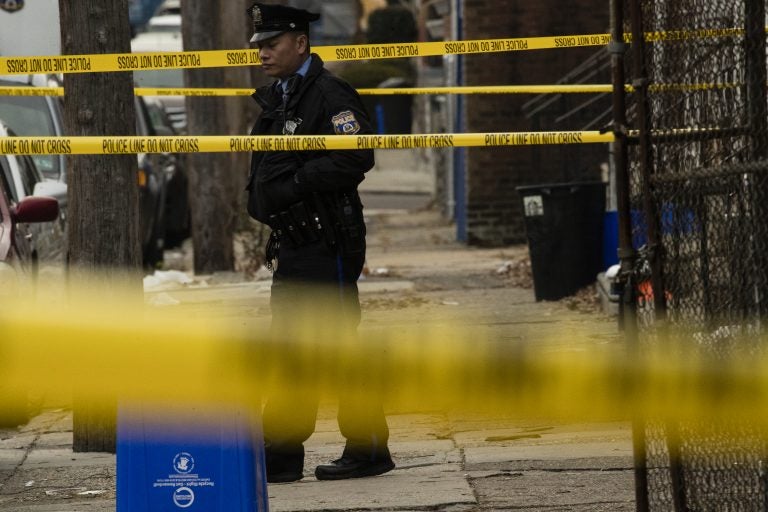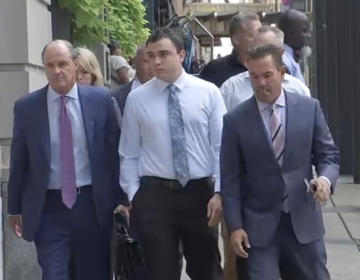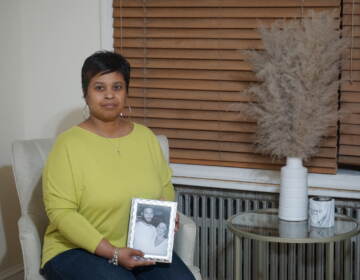Philly police: 60 percent of murders investigated in 2018 remain unsolved
Despite adding more detectives, Philadelphia police say 6 out of 10 murder cases investigated this year still not solved.

A police officer stands guard outside a home where a woman was murdered on Woodstock Street in Philadelphia, Friday, Dec. 14, 2018. (AP Photo/Matt Rourke)
Four out of every 10 murder cases Philadelphia detectives investigated this year ended with a suspect’s arrest. So the killers who committed 60 percent of the homicides examined in 2018 remain on the loose.
The homicide clearance rate is how police refer to the number of murder investigations that result in arrests. In 2018, 44 percent of homicide cases ended with a suspected perpetrator in custody, according to statistics police officials provided to WHYY.
That clearance rate, well below the national average, comes as the city tallies more homicides this year than it has in more than a decade.
The national homicide clearance rate is around 60 percent, according to FBI data.
In Philadelphia, the rate has been below 50 percent for some time. Last year, it stood at 42 percent. In 2016, around 45 percent of murders investigated ended in arrests, according to police department statistics.
A string of retirements last year in the homicide unit brought the number of detectives working murder cases to 61, a historically low number. In response, top police brass promised to beef up the unit’s ranks; now about 80 detectives are working in the unit.
Research into homicide investigations shows that solving a murder depends on how fast officers get to the crime scene, how many witnesses are located, how many detectives are assigned to the case, and, sometimes, just how motivated detectives are to solve the killing.
Not too long ago, in 2013, Philadelphia police investigators captured murderers 71 percent of the time.
Since then, that arrest rate has been dropping, which in turn erodes public confidence in police, according to Temple University criminal justice professor Jerry Ratcliffe.
“The homicide clearance rate is the one measure that really sends a signal to the community about the effectiveness of the police department — and how much they’re able to deal with the aftermath of violent crime,” Ratcliffe said.
Ratcliffe says police requirements that started in 2014 from a deal with the ACLU may still be having an impact. Under the new policies, homicide interrogations are video-recorded and potential suspects are permitted to leave the questioning at any time. The rules were aimed at providing safeguards to a suspect’s civil rights, and to ensure false confessions are not coerced, although Ratcliffe said the policies complicate murder investigations where nobody involved is eager to speak with authorities.
“That had an impact on the homicide unit’s ability to clear cases,” he said. “But it also requires the police department to rethink how they conduct investigations, and I don’t think they’ve made that transformation yet.”
Perennial blame is placed on the “stop snitching” culture in which people who could be witnesses or provide important information about killings instead honor a street code of silence. Ratcliffe said it will be difficult to eradicate that norm.
“We’ve had a no-snitching kind of campaign for a number of years, pretty much since I’ve been in Philadelphia, certainly the last 10-15 years, and that’s inhibited the capacity of detectives,” he said.
Some police officers put part of the blame for the high rate of unsolved murders on understaffing in the homicide department and cutbacks on overtime.
Ratcliffe, a former British cop who did consulting work for the police department under former Commissioner Charles Ramsey, said some of those are valid gripes.
He said investigators in the city should look across the pond for best practices around catching killers.
“In Philadelphia, for a homicide, you get a couple of detectives who worked the case for a couple of days, then it becomes one detective’s case,” he said. “You go to mainland Europe, and you’ll get teams of detectives, 20, 30 detectives, plus support staff, all working a homicide for weeks.”
WHYY is your source for fact-based, in-depth journalism and information. As a nonprofit organization, we rely on financial support from readers like you. Please give today.




